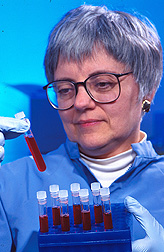Soy Soothes Cellular Circuits
|
|
 Chemist Norberta Schoene prepares blood samples for analysis on a flow cytometer. These blood samples were obtained from rats and used to study the effects of isoflavones on platelet function. (K8744-1) |
You've just sat down to dinner, and the phone rings. A pushy salesperson. Then your neighbor starts his lawn mower. After dinner, your daughter turns up the volume on her heavy metal CD. A little later your 3-year-old son throws a tantrum over going to bed. Jangled?
Perhaps that's how your cells feel when too many chemical signals—too many orders to do something—get through. And your cells may react before they should. For example, if an order to divide gets "heard" by too many cells too often, it can lead to unrestrained growth, as in cancer, or an overactive immune response. Likewise, if your blood cells are told to react to certain chemicals in the blood but tend to overreact, it can lead to cardiovascular disease and heart attack. Researchers now believe that poor regulation of signal transduction is a major factor behind some chronic diseases. Miraculously, cells usually do a pretty good job of filtering out noise and staying on task. "Foods play an important role," says ARS nutrition chemist Norberta Schoene. Soy, with its isoflavones like genistein and daidzein, is an example of a food that can affect cell response. Japanese diets average about 10 times more soy than North American diets. And Japanese people have a lower incidence of cancer and heart disease. Tofu, tempeh, and miso are some soy foods rich in isoflavones. In the late 1980s, Schoene says, researchers showed in test tube studies that genistein inhibits enzymes that connect the lines of communication from the cell's membrane into its interior. Her recent study gives the first direct evidence of this dampening effect in an animal. Schoene fed young rats diets containing soy protein with high or low genistein levels for 4 weeks. Then she measured the response of the animals' blood platelets in three different tests. Platelets are quite sensitive to outside signals because they have to clump together to prevent blood loss. So they serve as a good model for studying cell signaling, she explains. First, animals getting the genistein-enriched diet had significantly more platelets in the unactivated disk shape. Those getting little genistein had more of the rounder, activated platelets. "That's consistent with reports that platelets are apparently larger in activating environments such as those resulting from smoking, diabetes, and heart disease," she says. Second, hydrogen peroxide production—a necessary step in signal transduction—decreased in blood platelets of rats on the high-genistein diet. Third, the signal-carrying proteins from the high-genistein rats were less likely to have phosphate groups attached. "These phosphate groups help build the protein scaffolding that carries the signal," says Schoene. Her hypothesis: "Isoflavones may reduce overresponsive, dysfunctional signaling that leads to some chronic diseases." Schoene says the genistein-rich diets had the equivalent of twice the average Japanese genistein intake. But some Japanese eat as much as the rats got, she noted. The genistein-poor diet, on the other hand, was equivalent to the U.S. diet in genistein levels.—By Judy McBride, Agricultural Research Service Information Staff. This research is part of Human Nutrition, an ARS National Program (#107) described on the World Wide Web at http://www.nps.ars.usda.gov/programs/appvs.htm. Norberta W. Schoene is at the USDA-ARS Nutrient Requirements and Functions Laboratory, Bldg. 307, Room 215, 10300 Baltimore Ave., Beltsville, MD 20705-2350; phone (301) 504-8388, fax (301) 504-9062. |
|
"Soy Soothes Cellular Circuits" was published in the February 2000 issue of Agricultural Research magazine.
|
|






